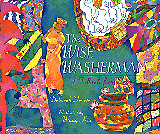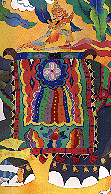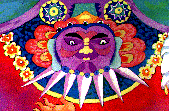


|
The Wise Washerman - A Folktale from Burma.
Deborah Froese. Illustrated by Wang Kui. Subject Heading:
Kindergarten - grade 5 / Ages 5 - 10. **** /4
|

excerpt:
Long ago in Burma, Washerman Aung Kyaing (Ahoong Ky-ang) bent over his steaming laundry tub, rubbing and scrubbing the clothes that were brought to him. Everyone believed that he worked magic in his washtub, for he made white clothes gleam like the snowcapped mountains and colourful clothes sparkle like jeweled pagodas. Aung Kyaing was happy to have the admiration of the people but knew that hard work was responsible for his success.
 The Wise Washerman - A Folktale from Burma is a well-told,
beautifully-illustrated picture book by Winnipeg author Deborah Froese. It
uses folklore to explore the complexities of the human spirit, to teach a
life lesson about using one's wits, and to overcome challenges and do what
is just.
The Wise Washerman - A Folktale from Burma is a well-told,
beautifully-illustrated picture book by Winnipeg author Deborah Froese. It
uses folklore to explore the complexities of the human spirit, to teach a
life lesson about using one's wits, and to overcome challenges and do what
is just.
It is the story of how a hardworking, honest man (Aung Kyaing)
deals with the machinations of a conniving, jealous neighbour (Narathu).
Narathu, a clay pot maker, directs his own energy into figuring out how to
get Aung Kyaing's riches, instead of learning the lesson that hard work
brings rewards. Narathu pricks the greedy heart of the proud king (Pagan
Min) by suggesting that he is less than regal because his ceremonial
elephant is not white in colour, like those ridden by the kings in Burmese
legends. Pagan Min orders Aung Kyaing to wash the ceremonial elephant until
it becomes white. The threat of banishment looms if he fails.

Luckily, Aung Kyaing is as clever as he is a talented washerman. He
convinces the king to order Narathu to construct a bowl large enough to
hold an elephant for washing. The elephant's weight cracks the bowl, and it
is Narathu who is banished for making an inferior bowl. Because there is no
bowl large enough to wash the elephant, Aung Kyaing resumes his life over
the washtubs, and good triumphs.
Deborah Froese writes lyrically. Her gentle, formal style, using
elevated language evokes pictures of ancient, ordered times. The
illustrations created by the talented Wang Kui are a perfect match. Using
pastel tones from goauche and watercolour he depicts the rich colours of
the king's palace, the tropical plants, the flowing silk clothes, and so on. The
background colours on each page are soft and complementary. The image of
the legendary white elephant is soft and dreamlike. The text on each page
is bordered by appropriate decorations from Burmese art.
The author recognizes that Burmese folk tales will be unfamiliar to
her audience, and includes the correct pronunciation of the characters'
names within the text. The book concludes with a useful Author's Note which
provides information about the geography and people of Burma. Anyone who
is up on current events will understand Froese's comments about the Burmese
government's secrecy and practice of limiting foreigners' access to the
country. She also informs the reader about the important Water Festival
celebrated in Burma.
This book would be a welcome addition to a library collection,
either as a picture book or as a folk tale from a country about which little
is written.
Highly Recommended
Harriet Zaidman is a teacher-librarian in Winnipeg.

To comment on this title or this review, send mail to cm@umanitoba.ca.
Copyright © 1996 the Manitoba Library Association. Reproduction for personal use is permitted only if this copyright notice is maintained. Any other reproduction is prohibited without permission.
Published by
The Manitoba Library Association
ISSN 1201-9364
AUTHORS |
TITLES |
MEDIA REVIEWS |
BOOKSHELF
BACK ISSUES |
SEARCH |
HOME